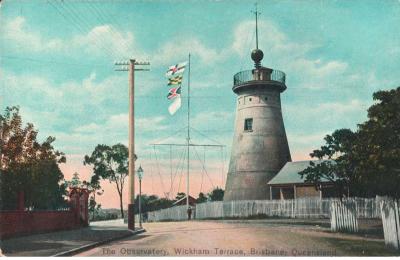
GSA Guide - Windmill Claimed
URPoint Details
This URP is provided and maintained by members of the Geological Society of Australia as a geo-located community knowledge service.
History:
The Windmill is the oldest remaining convict building in Queensland.
The Windmill, which is also referred to as 'Windmill Tower', is the oldest windmill tower in Australia. It played a role in the Moreton Bay convict settlement by milling flour and corn meal.
Originally two sets of millstones, one driven by the sails of the windmill and the other by a treadmill, provided the means of grinding the grain. The man-powered treadmill, which was in a separate building but connected to the mill stones in the Windmill, began grinding at the end of October 1828. The wind speed on the hill rarely reached the strength necessary to drive the sails for continuous milling, so the convict-powered treadmill is likely to have ground the majority of the grain, possibly having served as a means of punishment for disobedient convicts.
The milling operation ceased around the time the penal settlements at Moreton Bay officially closed in February 1842 and the treadmill was removed some time before 1849. From 1861 the windmill was used as an observatory and steamer signal station, fire spotting observation tower and site for pioneering telecommunication experiments. This meant the removal of the sails and all internal machinery, replacing floors and adding a central stairway.
A Time Ball was used to keep the time for the Brisbane citizens until 1866. Between 1866 and 1894 a cannon was fired to mark the time. A second time ball operated up to 1930, when the Brisbane Town Hall clock took on that role. In 1934 the first experimental television broadcast in Queensland was transmitted from the windmill.
Building Materials:
The windmill is a rendered stone and brick tower. Clay for the bricks was probably recovered from the Brick Fields which was an area between what are now Roma and George Streets.
This site became the first water supply for the settlement. A brick kiln was recorded near the western end of North Quay in 1825, and a sketch of the area between the river and the Windmill dated about 1835 shows a brick kiln on the slope below the windmill in the vicinity of what is now Roma Street Station.
The Brisbane Tuff used in the base and lower part of the tower was extracted from Kangaroo Point. The base of the tower sits on a circular sub-wall of porphyry (Formation: Brisbane Tuff) about 1.4 m thick which is founded on bedrock. The walls for the first and second floors which are about 1 m thick are also tuff laid in a random pattern. The quality of the rock was not very good and the tower has been cement rendered on the outside and painted inside to prevent deterioration.
Photographs taken during restoration work in 1988 indicate that sandstone probably from Tennyson was used in the construction of some sections of the upper part of the tower. A retaining wall along Wickham Terrace made of blocks of porphyry is a more recent addition.
Photos above are: Sketch of the Moreton Bay Settlement drawn from South Brisbane attributed to Henry W. Boucher Bowerman, ca. 1835; the brick kiln is on slope below Windmill. JOL151957 An early postcard showing the 'convict windmill', when it functioned as an observatory and signal station. The windmill including the garden wall made of vari-coloured Brisbane Tuff (porphyry). The windmill including the garden wall made of vari-coloured Brisbane Tuff (porphyry).
- Type:
- Landmark















